Tute M01 Boundaries SAGA: Difference between revisions
Chris Huxley (talk | contribs) No edit summary |
|||
| (2 intermediate revisions by 2 users not shown) | |||
| Line 1: | Line 1: | ||
== Introduction == |
== Introduction == |
||
This page details the method for using SAGA to create the GIS based boundary layer files. Once the GIS layers are setup (detailed in this page), these are linked to data using a boundary database, (the boundary database is described in [[ |
This page details the method for using SAGA to create the GIS based boundary layer files. Once the GIS layers are setup (detailed in this page), these are linked to data using a boundary database, (the boundary database is described in the <u>[[Tutorial_Module01_Archive#TUFLOW_Boundary_Condition_Database_.28bc_dbase.29 | Module 1 main page]]</u>). We will create three different boundaries: |
||
* Upstream flow boundary |
* Upstream flow boundary |
||
* Downstream water level - flow (stage-discharge) boundary |
* Downstream water level - flow (stage-discharge) boundary |
||
| Line 10: | Line 10: | ||
== Method == |
== Method == |
||
===2d_bc Type Boundaries=== |
===2d_bc Type Boundaries=== |
||
We will create the 2d_bc boundaries first. These boundaries are external and will "snap" to the edge of our active model area. Both of these boundaries have been aligned perpendicular to flow direction. |
We will create the 2d_bc boundaries first. These boundaries are external and will "snap" to the edge of our active model area. Both of these boundaries have been aligned perpendicular to flow direction. <br> |
||
''Note: This line orientation is recommended for 2d_bc QT, HQ and HT boundary inputs. Care should be taken to digitise these boundary types perpendicular to flow direction (i.e. across the waterway). If they are digitised oblique to the flow (i.e. not perpendicular) model instabilities can result in some cases.'' |
''Note: This line orientation is recommended for 2d_bc QT, HQ and HT boundary inputs. Care should be taken to digitise these boundary types perpendicular to flow direction (i.e. across the waterway). If they are digitised oblique to the flow (i.e. not perpendicular) model instabilities can result in some cases.'' |
||
<ol> |
<ol> |
||
| Line 73: | Line 73: | ||
<li>Save the file, by right clicking on it in the data tab and selecting save.</li> |
<li>Save the file, by right clicking on it in the data tab and selecting save.</li> |
||
</ol> |
</ol> |
||
== Conclusion == |
== Conclusion == |
||
SAGA has been used to create the 2d_bc layer that contains an upstream "QT" type inflow boundary and a downstream "HQ" stage-discharge type boundary. A second SAGA layer (2d_sa) defines an internal source boundary. Our next step is to assign hydrographs to the boundary locations created in this page. Please return to the tutorial model page [[ |
SAGA has been used to create the 2d_bc layer that contains an upstream "QT" type inflow boundary and a downstream "HQ" stage-discharge type boundary. A second SAGA layer (2d_sa) defines an internal source boundary. Our next step is to assign hydrographs to the boundary locations created in this page. Please return to the tutorial model page [[Tutorial_Module01_Archive#TUFLOW_Boundary_Control_File_.28TBC.29_Updates|here]]. |
||
Latest revision as of 12:58, 5 April 2024
Introduction
This page details the method for using SAGA to create the GIS based boundary layer files. Once the GIS layers are setup (detailed in this page), these are linked to data using a boundary database, (the boundary database is described in the Module 1 main page). We will create three different boundaries:
- Upstream flow boundary
- Downstream water level - flow (stage-discharge) boundary
- Internal flow boundary
The first two boundaries are input into a 2d_bc type layer. The third boundary (internal flow boundary) will be applied as a source-area boundary in a 2d_SA boundary type layer.
Method
2d_bc Type Boundaries
We will create the 2d_bc boundaries first. These boundaries are external and will "snap" to the edge of our active model area. Both of these boundaries have been aligned perpendicular to flow direction.
Note: This line orientation is recommended for 2d_bc QT, HQ and HT boundary inputs. Care should be taken to digitise these boundary types perpendicular to flow direction (i.e. across the waterway). If they are digitised oblique to the flow (i.e. not perpendicular) model instabilities can result in some cases.
- Load the DEM Module_Data\DEMs\SAGA\DEM_M01.sgrd
- Load the code polygon TUFLOW\model\gis\2d_code_M01_002_R.shp
- Create a new map containing these layers, select both of these in the data tab of the workspace window, right click and select "Show".
- Load the template 2d bc type layer (2d_bc_empty_L.shp) from TUFLOW\model\gis\empty\.
- Save a copy of the template under the TUFLOW\model\gis folder as 2d_bc_M01_002_L.shp. Note that we save the file into the \model\gis\ directory not the \model\gis\empty\ directory.
- Open the newly saved, 2d_bc_M01_002_L.shp add it to the map window and close the template. The SAGA window should now look something like this:
- The first step is to change the style of the code region to make it a bit easier to work with. Select the 2d_code_m01_002_R in the data tab, and then in the settings tab of the object properties window change the following:
- Set the Fill Style to "Transparent", this allows us to see the DEM behind the polygon;
- Set the Outline Size to 2, to make the object more visible;
- Check the "Show Vertices" option under Outline, this will allow us to see the vertices to snap the 2d_bc layer too.
- Before we begin modifying the 2d_bc layer, we need to enable snapping to the 2d_code region. To do this select the 2d_bc_M01_002_L.shp in the data tab, in the settings tab, select the "..." button next to the "Snap to.." text.
- In the snap to dialogue, select the 2d_code_M01_002_R in the left hand pane and move it to the right. Then select Okay. This layer is ready for input into TUFLOW.
- Set the Snap Distance to 10 (metres). This controls how closely you need to digitise a vertex in the new shape to be considered snapped to the code region. Select Apply.
- To add an object to the layer, right click on the layer in the workspace window and select Edit >> Add Shape.
- Digitise a line connecting the 4 vertices in the location show below. At each vertex, left click to create a vertex on the line, to finish the line use the right mouse button. Right click on the layer in the workspace and un-check the "edit selected shapes" option.
- Navigate to the attribute tab of the object properties window. Enter the following data:
- Type = QT
- Name = FC01 (that is FC Zero One).
- At the downstream boundary, add another shape connecting the four vertices shown below.
In the attributes window set the following:
- Type = HQ
- b = 0.01
- In the data tab, right click on the 2d_bc_M01_002_L layer and select "Save".
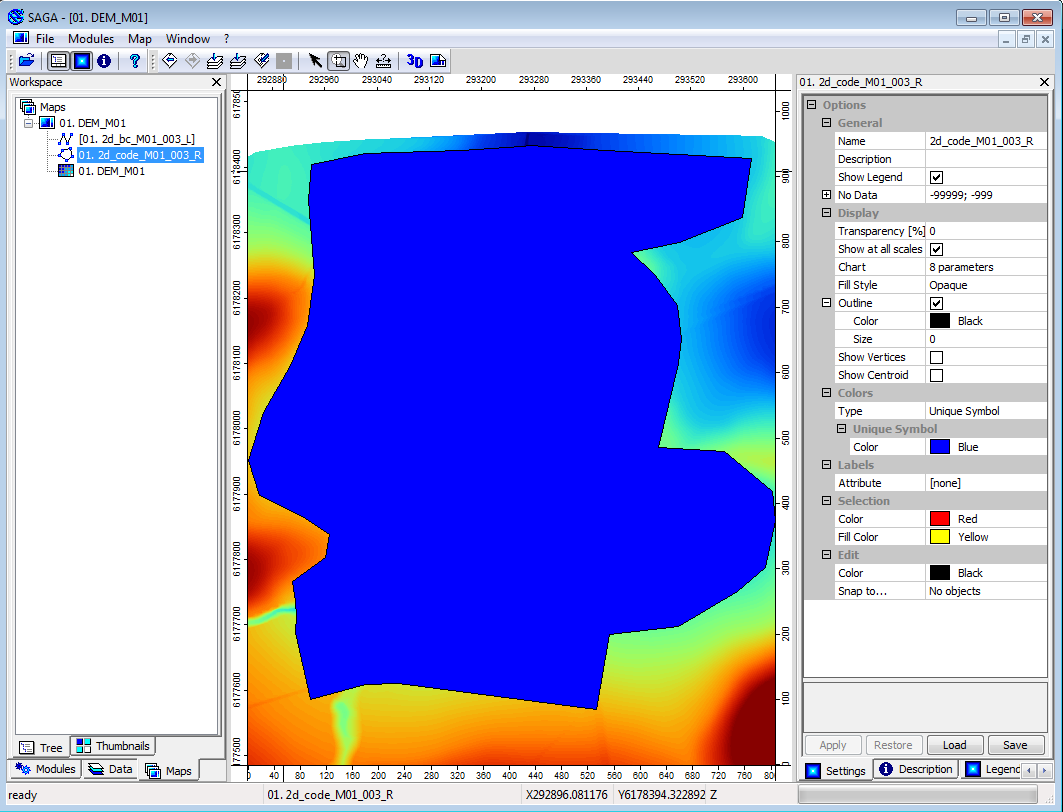
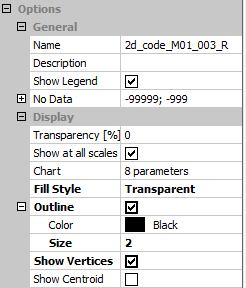

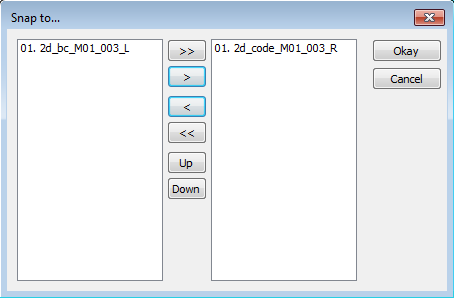
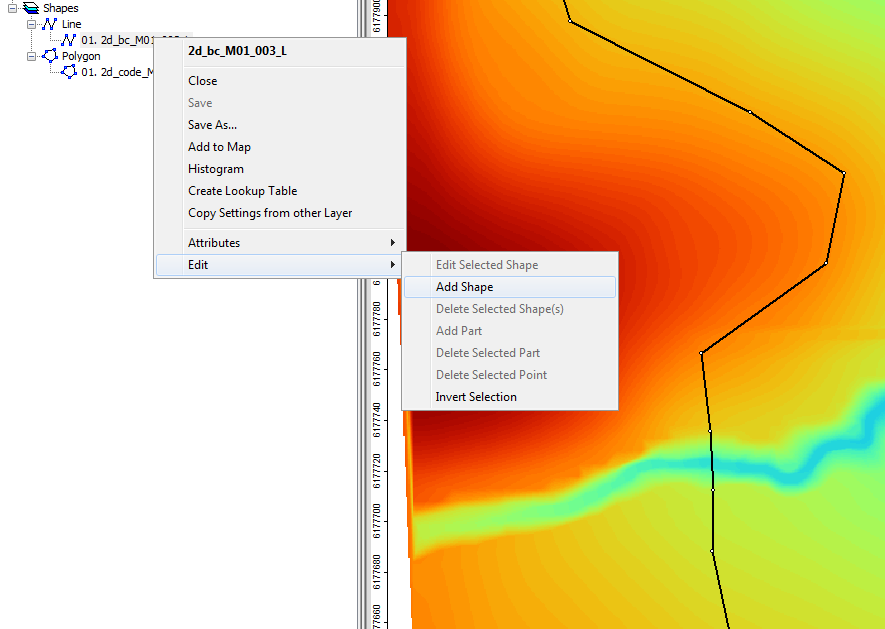
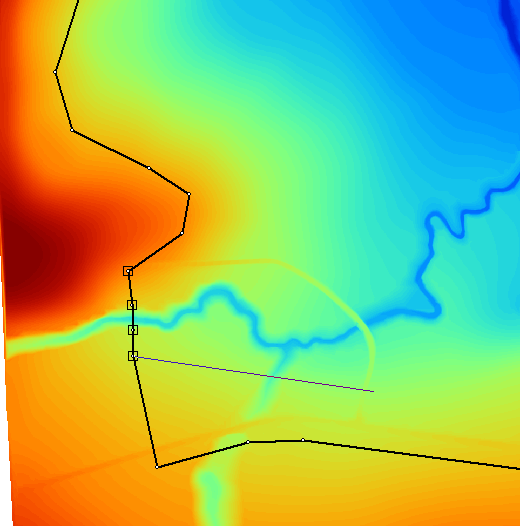
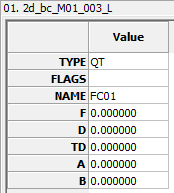
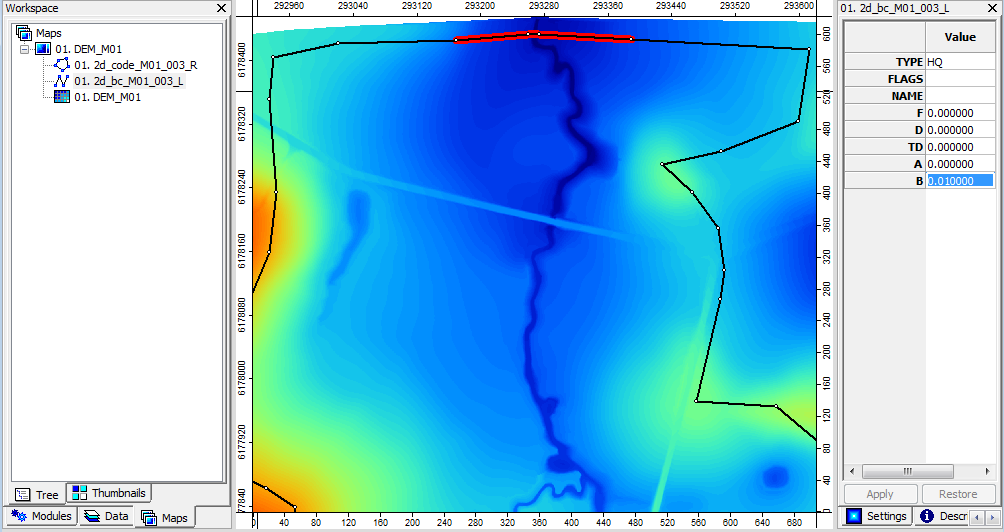
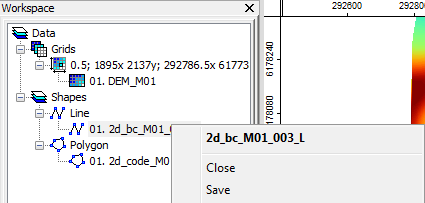
2d_sa Type Boundary
The next step is to create an internal inflow boundary using a source-area inflow this is done with a 2d_sa type layer.
- Load the 2d_sa_empty_R.shp template file from the TUFLOW\model\gis\empty\. Save a copy of the layer in the TUFLOW\model\gis\ directory as 2d_sa_M01_002_R.shp.
- Load the newly created 2d_sa_M01_002_R file and close the template file.
- Add the layer to a map window with the DEM.
- Add a new shape and digitise a polygon around the dam in the lower right (south-east) of the screen.
- Select the object in the map window, navigate to the attribute tab in the object properties window and enter "FC04" under the Name attribute (FC zero four, without the quotes).
- Save the file, by right clicking on it in the data tab and selecting save.
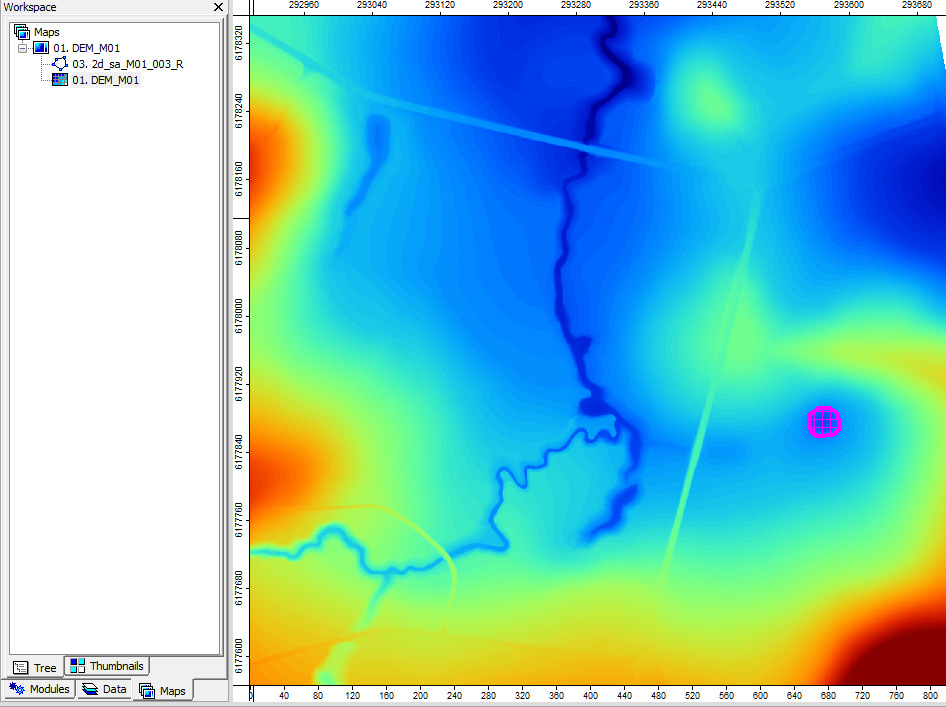

Conclusion
SAGA has been used to create the 2d_bc layer that contains an upstream "QT" type inflow boundary and a downstream "HQ" stage-discharge type boundary. A second SAGA layer (2d_sa) defines an internal source boundary. Our next step is to assign hydrographs to the boundary locations created in this page. Please return to the tutorial model page here.